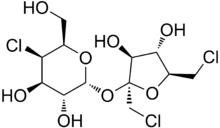Sucralose is an artificial sweetener and sugar substitute. As the majority of ingested sucralose is not metabolized by the body, it adds minimal calories (3 per gram).[3] In the European Union, it is also known under the E number E955. It is produced by chlorination of sucrose, selectively replacing three of the hydroxy groups—in the C1 and C6 positions of the fructose portion and the C4 position of the glucose portion—to give a 1,6-dichloro-1,6-dideoxyfructose–4-chloro-4-deoxygalactose disaccharide. Sucralose is about 600 times sweeter than sucrose (table sugar),[4][5] three times as sweet as both aspartame and acesulfame potassium, and twice as sweet as sodium saccharin.[4]
 | |
 | |
| Names | |
|---|---|
| IUPAC name 1,6-Dichloro-1,6-dideoxy-β-D-fructofuranosyl 4-chloro-4-deoxy-α-D-galactopyranoside | |
| Systematic IUPAC name (2R,3R,4R,5R,6R)-2-{[(2R,3S,4S,5S)-2,5-Bis(chloromethyl)-3,4-dihydroxyoxolan-2-yl]oxy}-5-chloro-6-(hydroxymethyl)oxane-3,4-diol | |
Other names
| |
| Identifiers | |
3D model (JSmol) | |
| ChEBI | |
| ChemSpider | |
| ECHA InfoCard | 100.054.484 |
| EC Number |
|
| E number | E955 (glazing agents, ...) |
| KEGG | |
PubChem CID | |
| UNII | |
CompTox Dashboard (EPA) | |
| |
| |
| Properties | |
| C12H19Cl3O8 | |
| Molar mass | 397.63 g·mol−1 |
| Appearance | Off-white to white powder |
| Odor | Odorless |
| Density | 1.69 g/cm3 |
| Melting point | 125 °C (257 °F; 398 K) |
| 283 g/L (20 °C) | |
| Acidity (pKa) | 12.52±0.70 |
| Hazards | |
| NFPA 704 (fire diamond) | |
Except where otherwise noted, data are given for materials in their standard state (at 25 °C [77 °F], 100 kPa). | |
The commercial success of sucralose-based products stems from its favorable comparison to other low-calorie sweeteners in terms of taste, stability, and safety.[4][6] It is commonly sold under the Splenda brand name.[4]
Uses
Sucralose is used in many food and beverage products because it is a no-calorie sweetener (3 calories per typical one gram serving),[3] does not promote dental cavities,[7] is safe for consumption by diabetics and nondiabetics,[8] and does not affect insulin levels,[9] although the powdered form of sucralose-based sweetener product Splenda (as most other powdered sucralose products) contains 95% (by volume) bulking agents dextrose and maltodextrin that do affect insulin levels.
Sucralose is used as a replacement for (or in combination with) other artificial or natural sweeteners such as aspartame, acesulfame potassium or high-fructose corn syrup. It is used in products such as candy, breakfast bars, coffee pods, and soft drinks. It is also used in canned fruits wherein water and sucralose take the place of much higher calorie corn syrup-based additives. Sucralose mixed with dextrose or maltodextrin (both made from corn) as bulking agents is sold internationally by McNeil Nutritionals under the Splenda brand name. In the United States and Canada, this blend is increasingly found in restaurants in yellow packets.[a]
Cooking
Sucralose is available in a granulated form that allows same-volume substitution with sugar.[10] This mix of granulated sucralose includes fillers, all of which rapidly dissolve in water. Sucralose is not hygroscopic when humidity is below 80%, which can lead to baked goods that are noticeably drier and manifest a less dense texture than those made with sucrose.[11]
Unlike sucrose, which melts when baked at high temperatures, sucralose maintains its granular structure when subjected to dry, high heat (e.g., in a 180 °C or 350 °F oven). Furthermore, in its pure state, sucralose begins to decompose at 119 °C (246 °F).[12] In some recipes, such as crème brûlée, which require sugar sprinkled on top to partially or fully melt and crystallize, substituting sucralose does not result in the same surface texture, crispness, or crystalline structure.[citation needed]
Safety evaluation
Sucralose has been accepted as safe by several food safety regulatory bodies worldwide, including the U.S. Food and Drug Administration (FDA), the Joint FAO/WHO Expert Committee Report on Food Additives, the European Union's Scientific Committee on Food, Health Protection Branch of Health and Welfare Canada, and Food Standards Australia New Zealand.
Maximum acceptable daily intake
Various assessments have reported different amounts of maximum acceptable daily intake (ADI), usually measured as mg per kg of body weight. According to the Canadian Diabetes Association, the amount of sucralose that can be consumed over a person's lifetime without any adverse effects is 9 milligrams per kilogram of body weight per day.[13][14] The FDA approval process indicated that consuming sucralose in typical amounts as a sweetener was safe.[14][15] The intake at which adverse effects are seen is 1500 mg/kg BW/day,[15] providing a large margin of safety compared to the estimated daily intake. The European Food Safety Authority (EFSA) proposed an ADI of 5 mg per kg (body weight) while the FDA established it as 15 mg per kg body weight, that is, 350–1050 mg per day for a person of 70 kg.[14]
Metabolism
Most ingested sucralose is directly excreted in the feces, while about 11–27% is absorbed by the gastrointestinal tract (gut).[14][15] The amount absorbed from the gut is largely removed from the blood by the kidneys and eliminated via urine, with 20–30% of absorbed sucralose being metabolized.[14][15]
Possible health effects
In reviewing a 1987 food additive petition by McNeil Nutritionals, the FDA stated that "in the 2-year rodent bioassays... there was no evidence of carcinogenic activity for either sucralose or its hydrolysis products".[15][16]
As of 2020, reviews of numerous safety and toxicology studies on sucralose concluded that it is not toxic or carcinogenic, even at levels of daily consumption much larger than those typically used.[14][15] A 2023 FDA summary declared that there were no concerns of sucralose toxicity on cancer risk, metabolism, the reproductive system or the nervous system, and no concern for people with diabetes.[4]
Baking
At normal baking temperatures, sucralose is heat stable, indicating that it retains its sweetness and is suitable as a sugar substitute for use in baked goods.[4]
History
Sucralose was discovered in 1976 by scientists from Tate & Lyle, working with researchers Leslie Hough and Shashikant Phadnis at Queen Elizabeth College (now part of King's College London).[17] While researching novel uses of sucrose and its synthetic derivatives, Phadnis was told to "test" a chlorinated sugar compound. According to an anecdotal account, Phadnis thought Hough asked him to "taste" it, so he did and found the compound to be exceptionally sweet.[18]
Tate & Lyle patented the substance in 1976; as of 2008, the only remaining patents concerned specific manufacturing processes.[19]
A Duke University animal study funded by the Sugar Association[20] found evidence that doses of Splenda (containing ~1% sucralose and ~99% maltodextrin by weight) between 100 and 1000 mg/kg BW/day, containing sucralose at 1.1 to 11 mg/kg BW/day, fed to rats reduced gut microbiota, increased the pH level in the intestines, contributed to increases in body weight, and increased levels of P-glycoprotein (P-gp).[21] These effects have not been reported in humans.[5] An expert panel, including scientists from Duke University, Rutgers University, New York Medical College, Harvard School of Public Health, and Columbia University reported in Regulatory Toxicology and Pharmacology that the Duke study was "not scientifically rigorous and is deficient in several critical areas that preclude reliable interpretation of the study results".[22]
Sucralose was first approved for use in Canada in 1991. Subsequent approvals came in Australia in 1993, in New Zealand in 1996, in the United States in 1998, and in the European Union in 2004. By 2008, it had been approved in over 80 countries, including Mexico, Brazil, China, India, and Japan.[23] In 2006, the FDA amended the regulations for foods to include sucralose as a "non-nutritive sweetener" in food.[24] In May 2008, Fusion Nutraceuticals launched a generic product to the market, using Tate & Lyle patents.
In April 2015, PepsiCo announced that it would be moving from aspartame to sucralose for most of its diet drinks in the U.S.[25] due to sales of Diet Pepsi falling by more than 5% in the U.S. The company stated that its decision was a commercial one, responding to consumer preferences.
In February 2018, PepsiCo went back to using aspartame in Diet Pepsi because of an 8% drop in sales for the previous year.[26][27]
Chemistry and production
Sucralose is a disaccharide composed of 1,6-dichloro-1,6-dideoxyfructose and 4-chloro-4-deoxygalactose. It is synthesized by the selective chlorination of sucrose in a multistep route that substitutes three specific hydroxyl groups with chlorine atoms. This chlorination is achieved by selective protection of one of the primary alcohols as an ester (acetate or benzoate), followed by chlorination with an excess of any of several chlorinating agent to replace the two remaining primary alcohols and one of the secondary alcohols, and then by hydrolysis of the ester.[28][29]
Storage
Sucralose is stable when stored under normal conditions of temperature, pressure and humidity.[30] Upon prolonged heating during storage at elevated temperatures (38 °C, 100 °F), sucralose may break down, releasing carbon dioxide, carbon monoxide and minor amounts of hydrogen chloride.[30]
Effect on caloric content
Though sucralose contains minimal calories (3 per gram),[3] products that contain fillers such as dextrose and/or maltodextrin add about 2–4 calories per teaspoon or individual packet, depending on the product, the fillers used, brand, and the intended use of the product.[31] The FDA allows for any product containing fewer than 5 calories per serving to be labeled as "zero calories";[32] a typical one gram serving packet of sucralose supplies 3 calories derived from its composition as 0.9 gram of carbohydrates and 0.1 gram of water.[3]
Research
There is no evidence of an effect of sucralose on long-term weight loss or body mass index, with cohort studies showing a minor effect on weight gain and heart disease risks.[33]
Environmental effects
According to one study, sucralose is digestible by a number of microorganisms and is broken down once released into the environment.[34] However, measurements by the Swedish Environmental Research Institute have shown sewage treatment has little effect on sucralose, which is present in wastewater effluents at levels of several μg/L (ppb).[35] No ecotoxicological effects are known at such levels, but the Swedish Environmental Protection Agency warns a continuous increase in levels may occur if the compound is only slowly degraded in nature. When heated to very high temperatures (over 350 °C or 662 °F) in metal containers, sucralose can produce polychlorinated dibenzo-p-dioxins and other persistent organic pollutants in the resulting smoke.[36]
Sucralose has been detected in natural waters, but research indicates that the levels found in the environment are far below those required to cause adverse effects to certain kinds of aquatic life.[37]
See also
Footnotes
References



